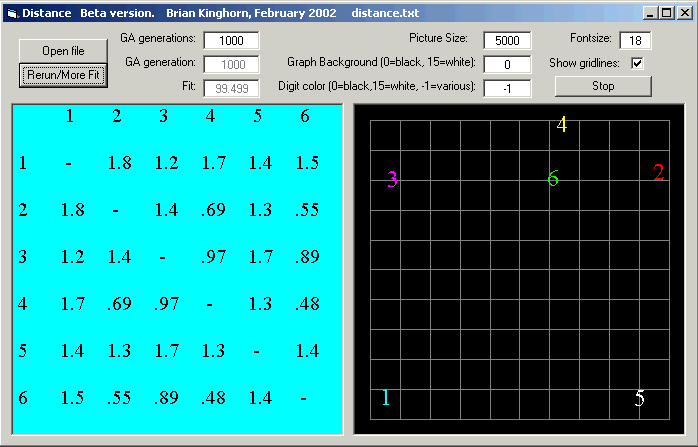DISTANCE
|
Written by Brian Kinghorn.
DESCRIPTION
Genetic distances between populations (or between individuals) are supplied in your text file. The program uses an evolutionary algorithm to find suitable placings on a 2-dimensional surface, as shown above. The correlation between Euclidean distance on this graph and genetic distance supplied is, in the above example, 99.499%.
For more information, see Kinghorn, B.P. and Shepherd, R.K. 2001. A graphic display of genetic distances between populations. Assoc. Advmt. Anim. Breed. Genet. 14: 273-276. Also see GENUP module DIVERSITY.
Downloading and
running DISTANCE
Download distance.zip and save it in an empty
directory on your hard disk (you can delete this directory and all its files
after installation). If you have a capable program such as WinZIP, you can execute SETUP.EXE directly. Otherwise
unzip the file. If you do not have an unzipper,
you can download pkunzip.exe,
into the same directory, and then run:
pkunzip distance.zip at the
DOS prompt.
Three files will be produced. Run the file SETUP.EXE and follow instructions.
[NB. You may be told that some system files need updating. This is done
by Microsoft, whose recent VB6 compiler was used for making DISTANCE. In
this case you will need to re-run SETUP.EXE after updating your system
files. If you have a problem, go to http://support.microsoft.com/default.aspx?scid=kb;EN;q191096].
After installation, a start menu item which runs the installed program will
result.
Run DISTANCE.exe. The program reads your text file. The data in the
txt file is the number of populations followed by the top-right of the distance
matrix, as in the supplied example, distance.txt, shown here:
|
6 Number of populations |
OR |
6 Number of populations |
Good Luck!
Return to Brian Kinghorn's homepage.

